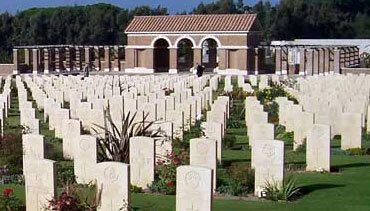Ghosts of Soldiers at Anzio
My father told me about Anzio. He showed me a yellowed newspaper with heavy, black 64-point headlines from World War II. “A-N-Z-I-O. What does it mean?” I asked.
“It’s a beach in Italy,” he said. “My best friend died there in the war.”
That snippet of memory surfaced recently when my husband, Richard, and I visited Ostia, the seaside town south of Rome. We had toured the remarkable ruins at Ostia Antica, saw the sentinel tower designed by Michaelangelo, and admired the colorful art deco buildings lining the boulevard. On the last day of our trip, we were driving to the shore for a romantic sunset stroll along Italy’s only dune beach when we spied the sign: Anzio 37 km.
The name resonated. Impulsively, we decided to forego the beach and head towards Anzio. Our guide book offered no information, but I’d read Gerard M. Devlin’s book, Paratrooper! The Battle of Anzio, code name Shingle, supported the operation to liberate Rome, 30 miles to the north. In the early morning of January 22, 1944, under cover of darkness, a convey of 374 Allied ships entered the harbor. With surprise on their side, troops quickly established a beachhead three miles deep and 15 miles wide before the Germans who occupied the territory were alerted.
Unfortunately, Allied troops hesitated, giving the enemy time to amass forces and surround them. Fighting with heavy casualties continued until May. Rome didn’t fall until June 4. Sir Winston Churchill, the plan’s biggest booster, later said, “I had hoped that we would be hurling a wildcat ashore, but all we got was a stranded whale.”
By the time Richard and I arrived at Anzio, twilight veiled the port. We could barely read the plaque by the foot of the statue of a woman cradling an infant in her arms. Erected in 1979, it memorializes a peculiar pairing: The United Nations “Year of the Child” and the Anzio landing.
The statue gazes out at the beach where a rocky breakwater hugs the wide harbor, now crowded with pleasure craft. Gentle waves lapped the beach. A jogger kicked plumes of sand as he passed. Glowing cigarettes revealed the silhouettes of couples hidden in the shadows.
It was dark when we left to search for the military cemetery. In the town center, next to the war museum, the window of The Big Apple, a popular bar, glowed with the image of an American flag in red, white and blue light bulbs. It illuminated the town’s busiest corner.
A discreet sign by the side of the road directed us to the cemetery. The Church of St. Therese sits at the crest of a small hill, flanked by the parish cemetery and the military cemetery. The church and the parish cemetery were securely locked. The gate to the military cemetery stood ajar, as if we were expected.
For as far as we could see, row on row of headstones lined up, not crosses nor stars of David as I’d expected but arched white headstones, luminous in the moonlight. The full moon shed light enough to read the inscriptions. These were Australian graves. Richard and I walked among the stones, saying names and where they were from, our voices melting into the night. With every breath, I inhaled the too sweet fragrance of roses that grew between every third or fourth gravesite.
Like the aroma of Proust’s madelaines, the scent stirred memory. There were fresh roses on the table at the trattoria where we’d had dinner our first night in Rome. The good-natured proprietor had translated the Italian menu. His hospitable wife brought samples for us to taste so we’d be satisfied with our choices.
Paintings by unknown artists covered the restaurant, wall to wall, floor to ceiling. Many pictures were dedicated to our host, a rotund man with wispy white hair and a ready smile. He pointed to a photograph prominently displayed above the paintings, a young likeness of himself in a World War II uniform with another man.
“Mussolini,” he said “A very great man.” He saluted the picture of the Italian dictator and ally of Adolph Hitler.
Now standing among the graves at Anzio, I thought about that old soldier, the young soldiers buried here, and war. It challenged my understanding. The question I asked my father long ago persists: What does it mean?
Boston-based, freelance writer Shirley Moskow left daily journalism for the life of a footloose freelancer. She often writes about art and travel.



